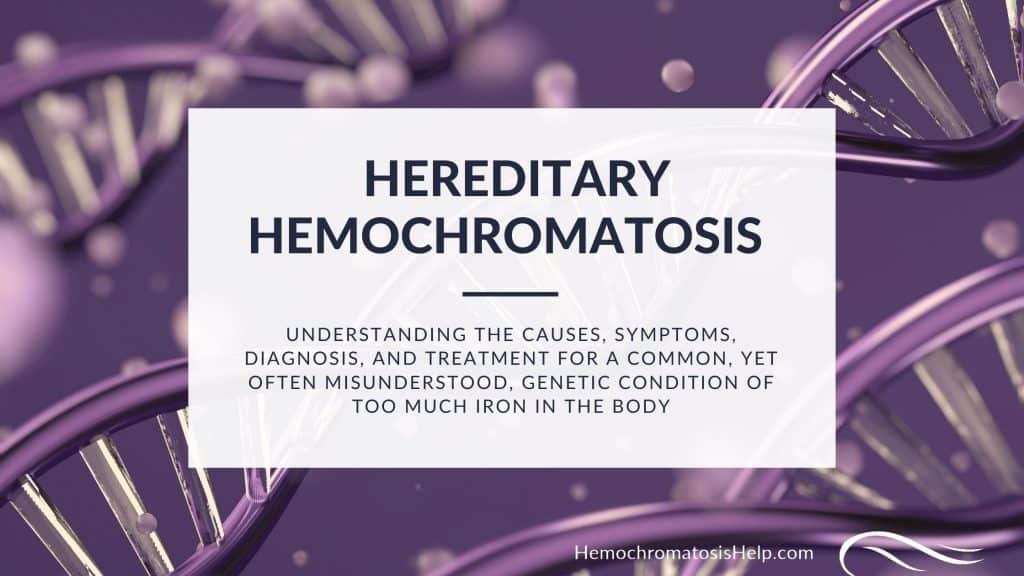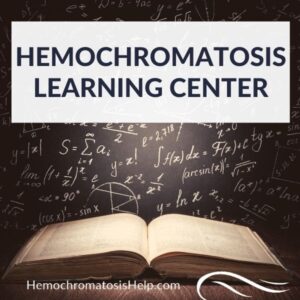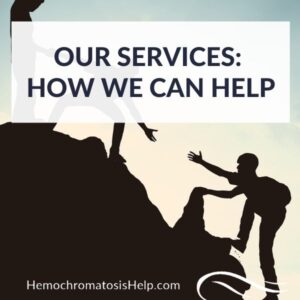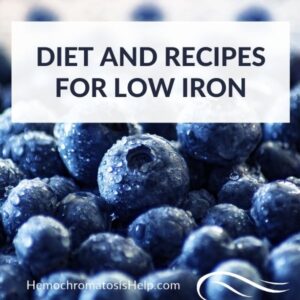Understanding Hemochromatosis and Iron Overload
You are not alone!
Millions of individuals and their families from around the world are affected by iron overload.
Whether caused by Type 1 hereditary hemochromatosis or another condition leading to excess iron in the body, the shared reality is a struggle to find answers.
Perhaps this is why you are searching the internet right now, trying to understand why you or your loved one feels poorly.
You may be on your smartphone in bed, researching in the dark while your other family members sleep.
You may have just returned from an appointment with your doctor with this new diagnosis of “hemochromatosis,” a strange-sounding condition that you’ve never even heard of before today.
Perhaps you’ve been dealing with iron overload for years. Still, you’re tired of not really understanding what’s going on with your body, and you’d like more clarity and knowledge to feel your best.
You Are Not Alone
Iron overload and hemochromatosis are frequently under-diagnosed or misdiagnosed. As a result, numerous people have the condition and do not know it.
Some estimates show that 1 in 9 people of Northern European descent are carriers of the HFE gene mutation that can lead to hereditary hemochromatosis.
Entire families may be impacted without their knowledge!
Too much iron can cause a myriad of symptoms ranging from mild to severe, including complications that may be fatal.
It’s exceedingly common for someone with undiagnosed hemochromatosis to struggle for years without any help.
On the other hand, with properly identified excess iron, a lot can be done to improve your chances of having a long, healthy life.
Is there anything you can do to help improve your quality of life?
You bet!
This article details the condition of hemochromatosis, including the symptoms, causes, prognosis, life expectancy, diagnosis, and treatments, as well as ideas for steps you can take right now to take charge of your health with iron overload.
Let’s get started!
In This Article:
What is Hemochromatosis?
Just what is hemochromatosis, after all?
Because you are reading this page, you or a family member have likely been diagnosed with iron overload.
It is also possible you are having a hard time pronouncing, or even spelling, hemochromatosis!
Hereditary hemochromatosis is a genetic metabolic disorder of excess iron absorption from the diet.
While blood levels of iron may be elevated, the primary problem stems from the accumulation of iron in the body’s cells, tissues, and organs.
The process of iron overload is typically slow to develop. It may not affect a person’s health until they are in their 30s or 40s or even their 50s or 60s.
Symptoms can range from mild to severe, and the disease can ultimately be fatal if not identified in time.
Why is Too Much Iron a Problem?
Iron is an essential mineral that our bodies require to build red blood cells to deliver oxygen to our cells so they can create energy. Without iron in our bodies, our cells would die, and we couldn’t survive!
Even people with iron overload and hemochromatosis need iron to be healthy and for basic bodily functions.
The problem in hemochromatosis, however, is that the body absorbs more iron than it needs. This excess iron is then stored in the liver, heart, and organs.
If you’ve ever seen a rusty nail, you know what can happen when iron and oxygen mix. People with too much iron inside can start to literally rust from the inside, causing damage to their organs.
To understand why iron can cause such damage, you may also wish to learn more about the process of iron overload and what actually happens in the body.
How Common is Genetic Hemochromatosis?
The most common form of iron overload, Type 1 hereditary hemochromatosis, impacts millions of people worldwide.
However, due to underdiagnosis, the number of people with this condition may be higher than the official figures.
Estimates show that between 1 in 150 to 1 in 300 people of Northern European descent may carry the two genes necessary for a diagnosis of hereditary hemochromatosis.
Other people may have symptoms and consequences of excess iron in their bodies, even if they don’t fit the textbook definition of Type 1 hereditary hemochromatosis.
As mentioned earlier, 1 in 9 people with ancestors from Northern Europe may have inherited at least one copy of the gene that causes iron overload.
Many healthcare practitioners commonly believe that those people with only one copy never have symptoms of excess iron. In reality, some people with only one copy do have symptoms and high blood iron.
Type 1 hemochromatosis accounts for approximately 90% of genetically caused iron overload. Other genetic forms of hemochromatosis (Types 2-4), as well as non-genetic causes, are discussed later in this article.
What are the Symptoms of Hemochromatosis?
Iron overload can be tiring, painful, complex, and confusing. The symptoms of hemochromatosis range from mild to severe and can occur daily or periodically.
Common Hemochromatosis Symptoms
Two of the most common and prominent hemochromatosis symptoms are generalized pain and fatigue.
Pain in Iron Overload
Iron overload hurts.
Nearly all individuals will experience some degree of joint, muscle, or body pain.
This was my first clue when I began to suspect I might have iron overload. I began to have knee pain without any injuries or overuse. Both of my knees progressively became painful, stiff, and sore.
Fatigue in Iron Overload
Likewise, having too much iron is exhausting.
Typically iron deficiency is associated with fatigue. Worldwide, iron deficiency is more common than iron excess. Therefore iron deficiency receives the majority of the attention with respect to iron disorders.
While fatigue is the hallmark of iron deficiency, tiredness is also a characteristic of too much iron.
Feeling less energy, being unable to enjoy or even complete daily activities, and waking unrefreshed in the morning—these are all common symptoms of hemochromatosis.
Other Common Symptoms of Iron Overload
Other symptoms that may not be considered severe, but that definitely impact the quality of life include:
- Restlessness
- Irritability and anger
- Trouble concentrating
- Mood swings
- Shortness of breath
- Frequent infections and illness
- Digestive disturbances
- Trouble relaxing
Serious Complications of Hemochromatosis
Well beyond the low energy and painful soreness, hemochromatosis carries a significant risk for long-term health consequences.
Iron absorption and accumulation builds over a lifetime and can lead to the following:
- Organ damage: especially of the liver, pancreas, endocrine glands, cardiovascular system, and skin
- Liver cirrhosis and liver cancer
- Insulin resistance and diabetes
- Bronze diabetes: a skin condition associated with iron overload and diabetes
- Hypogonadism and low libido
- Arthritis: most commonly in the knees, hands, and wrists
- Osteoporosis and bone loss
- Neurological disorders: including Parkinson’s Disease, dementia, and Alzheimer’s Disease
- Decreased healthspan, longevity, and lifespan
What is the Prognosis and Life-Expectancy in Hemochromatosis?
Unchecked, severe cases of iron overload can progress through some, or all, of these serious complications.
Hemochromatosis may shorten life expectancy. It can be fatal.
If hemochromatosis is diagnosed after organ damage has already occurred, there may be permanent scarring of the liver, which in turn may lead to liver cancer.
Iron overload can progress to the point where symptoms and damage are irreversible.
Studies looking at groups of patients with hemochromatosis have found that the most significant factor impacting life-expectancy is whether cirrhosis liver damage had already happened by the time the condition was diagnosed.
If the liver damage had not started, then the life-expectancy was exactly the same as the non-hemochromatosis population! [reference]
From the Indiana Hemophilia and Thrombosis Center, a team of hematologists working with hemochromatosis patients has written:
Among affected persons, the iron concentration in the liver is a major determinant of the risk of cirrhosis (scarring) of the liver and, in turn, of hepatocellular carcinoma (liver cancer). These are the two major causes of death associated with hereditary hemochromatosis. The development of cirrhosis increases the risk of hepatocellular carcinoma more than 200-fold. If the disease is diagnosed before tissue injury has occurred, phlebotomy to remove the excess iron can prevent all of the complications of hemochromatosis and return the patient’s life expectancy to normal. If organ damage is present, progression is prevented by phlebotomy, which can also decrease symptoms.
This is why identifying, diagnosing, and treating hemochromatosis as early as possible is crucial to improved prognosis!
Fortunately, with early detection and treatment, these severe hemochromatosis symptoms are often manageable and preventable, and life expectancy is not shortened at all.
What are the Causes of Hemochromatosis?
For most people, the condition of iron overload is genetically inherited. This is why it is referred to as hereditary hemochromatosis.
But genetic inheritance is not the only way someone can develop iron overload.
What are the Genetic Types of Hemochromatosis?
There are four main types in the family known as hereditary hemochromatosis, each caused by a mutation to a different gene in the body.
- Type 1: This is the most common form, estimated to account for 90% of hemochromatosis cases. When someone says they have hemochromatosis, this is usually the kind they have. A mutation to the HFE gene (located on chromosome 6) causes this form of hemochromatosis. (More on this type of hemochromatosis in a moment).
- Type 2: This is also known as juvenile hemochromatosis. Juvenile hemochromatosis is rare, and symptoms typically appear before age 30. It is caused by mutations of different genes (the HJV and HAMP genes). (Read more about Juvenile Hemochromatosis)
- Type 3: This form is also rare. It is related to a change in the TFR2 gene. Like juvenile hemochromatosis, Type 3 (or TFR2-related hereditary hemochromatosis) is often diagnosed before age 30. (Read more about Type 3 Hemochromatosis)
- Type 4: Also known as ferroportin disease, this rare condition most often found in those of Southern European descent, is caused by a change in the SLC40A1 gene. This form may start anytime from childhood to adulthood. (Read more about Ferroportin Disease)
What are Non-Genetic Causes of Iron Overload?
Not everyone with iron overload has a genetic mutation causing their symptoms.
Secondary, non-genetically determined causes include:
- Blood Transfusion Related Hemochromatosis
- Iron in Water
- Iron in Supplements
- Neonatal Hemochromatosis
Secondary (Non-Hereditary) Forms of Iron Overload
Several other causes of iron overload are due to factors other than genetics.
These forms of iron overload are not due to hereditary factors. Instead, they are caused by secondary factors from the diet, environment, or medical treatment for other conditions.
Even though non-hereditary related cases of iron overload have nothing to do with genetic inheritance, these conditions may have similar consequences due to chronically elevated levels of iron.
Common Secondary (Non-Hereditary) Causes of Iron Overload
Excess Dietary Ingestion of Iron
The body has no means for excreting excess iron once it is absorbed. If an individual consumes high amounts of iron in dietary supplements, food, or even water, they may be vulnerable to iron overload.
Transfusional Iron Overload
Secondary iron overload may occur as a result of receiving blood transfusions for other medical conditions.
Examples of conditions that may require transfusions include:
- Thalassemia
- Aplastic Anemia
- Myelodysplastic Syndrome
- Diamond-Blackfan Anemia
- Sickle Cell Anemia
- And more
Not Everyone with Iron Overload is Irish!
Especially in individuals with secondary iron overload, it’s common to find people who don’t fit the stereotype of someone of “Northern European descent.”
Hemochromatosis is sometimes called the “Celtic Curse,” but many people worldwide who don’t identify as having Celtic ancestry can and do have issues with iron overload.
Because of the medical community’s stereotype that only those with European heritage develop iron overload, some individuals of other ethnicities with excess iron are never tested by their doctors. This leads to even more under-diagnosis or misdiagnosis.
Can Hereditary Hemochromatosis be Prevented?
If you have a genetic form of hemochromatosis, there is no way to prevent it, as it is part of the genetic makeup of who you are.
You can, however, prevent or at least manage some of the symptoms and complications. This is done by an early diagnosis as well as by being diligent about following treatment options (see below for more details) to keep the disease from getting worse.
Additionally, if you discover you have the genetics for hemochromatosis before developing symptoms, you can be proactive in managing your iron overload before serious complications or organ damage starts.
Will I Pass Hemochromatosis To My Family Members?
Hemochromatosis is not contagious, so you can’t give it to someone else just by being in the same room with them or by sharing your donated blood with a blood bank.
But as an inherited disease, it does mean that parents may pass it on to their children.
Hemochromatosis runs in families, often for multiple generations. It’s not uncommon for cousins, uncles, grandparents, nieces, and siblings to also learn that they share the same genetic traits.
It’s often the diagnosis of one person that can lead to the others having the information they need to discover their own iron overload status.
In these four genetic types of hereditary hemochromatosis, it is important for family members of an affected person to get tested for their iron levels and genetic markers.
If you have not already, please let your blood relatives know that you have been diagnosed with this condition. The earlier someone is diagnosed, the better their lifetime prognosis.
If you have it, then those you love may have it, too. Help make a difference by alerting them so they can ask their doctor about hemochromatosis.
Awareness is essential in hemochromatosis!
How is Hemochromatosis Diagnosed?
Hemochromatosis is often diagnosed by a combination of lab tests used to look at iron markers in the body and then confirmed by genetic analysis.
As an inherited condition passed down to other blood relatives, a healthcare provider may be alerted to check for this condition after another family member tests positive.
A maddening aspect of hemochromatosis is that no two individuals experience iron overload in precisely the same way. In part, this explains why so many doctors fail to consider hemochromatosis when diagnosing a patient.
Unfortunately, serum iron testing is not part of the routine bloodwork done during most annual physical exams. It is even rarer for a healthcare provider to order a ferritin or transferrin saturation blood test.
On the other hand, it is exceedingly common for a person with hemochromatosis to struggle for years or even decades without a proper diagnosis, all the while their health is seriously at risk.
Lab Tests to Diagnose Hemochromatosis
Many people start the journey toward a hemochromatosis diagnosis through a lab test to look at iron markers.
An iron panel blood test may be ordered because your doctor suspects iron overload, because you have other unusual tests such as elevated liver enzymes, or because one of your family members has been diagnosed.
A complete iron panel typically includes:
- Serum Iron
- Ferritin
- Transferrin Saturation % (TS%)
- TIBC/UIBC
Of these tests, the most helpful in diagnosing iron overload are ferritin and transferrin saturation. Both of these are often elevated in hemochromatosis.
Genetic Tests to Diagnose Hemochromatosis
If your lab tests come back with elevated ferritin and/or transferrin saturation, the next step in diagnosing hemochromatosis is often a genetic test.
Many times doctors may not find it necessary to jump straight to the genetic testing, but if you know it runs in your family, your doctor may run the genetic analysis at the same time as the other bloodwork. Many times the genetics are only checked after abnormal numbers show up from the iron panel.
The hemochromatosis gene testing is often a blood test, but sometimes it involves swabbing the inside of your mouth to collect cells for a DNA evaluation.
Both versions of the test are looking for DNA changes to the HFE gene.
The test will look to see if you have one or two copies of any of the following genes: C282Y and H63D.
Different combinations are correlated with different levels of disease.
Making the Diagnosis of Hemochromatosis
The classic diagnosis of hemochromatosis is someone with 2 copies of the C282Y gene, elevated ferritin, and elevated transferrin saturation.
Someone with those results (plus relevant symptoms) will likely receive a diagnosis of Type 1 hereditary hemochromatosis.
The majority of hemochromatosis patients in our naturopathic practice fit this description.
However, just like many other medical conditions, not everyone fits into the textbook definition.
Many people with only one copy of the gene or with unusual lab results may still experience high iron symptoms.
Their need for taking steps to lower iron may be similar to those with a clear-cut hemochromatosis diagnosis.
For example, in our practice, we’ve also worked with patients that have hemochromatosis genes who also:
- Have low ferritin
- Have low transferrin saturation % (TS%)
- Have low ferritin and high TS% (or vice versa)
- Have anemia at the same time as having high ferritin
- Struggle to lower their ferritin levels even with consistent phlebotomy
- Are not able to receive or tolerate phlebotomy
In fact, my own story is that I only have one copy of the genetics but absolutely have elevated iron if I’m not careful. I feel immediate symptom relief after phlebotomy and benefit personally from dietary and supplement strategies to keep my body healthy.
What are the Treatments for Hemochromatosis?
The good news is that there are excellent treatments that, if started early enough, are often successful in controlling the condition of too much iron, reversing symptoms, and improving overall health.
Available therapies fall into 3 main categories:
- Therapeutic Phlebotomy
- Iron-Chelating Medications
- Diet and Nutritional Supplements
More on all three of these below, but first, let’s talk about what kind of doctor treats hemochromatosis patients.
What Kind of Doctor Treats Hemochromatosis?
The most common specialist who works with hemochromatosis patients is a hematologist. Hematologists are doctors who specialize in working with a wide range of blood disorders.
Technically, hemochromatosis isn’t a “blood disorder” as the problem is more one of metabolism, digestion (increased iron absorption), and iron deposits in the organs. This means the problem in hemochromatosis isn’t actually because of the blood itself.
Because there’s no such thing as a “hemochromatosisologist,” however, the closest type of doctor is a hematologist.
Hematologists frequently work with patients with blood cancers. As a result, sometimes newly-diagnosed hemochromatosis patients worry that they have cancer since they are being sent to a “blood cancer center” and may be working with a “blood cancer oncologist.”
Do not worry! Hemochromatosis is not cancer.
Yes, it is considered a risk factor for cancer, specifically liver cancer, but just because you have hemochromatosis and because you may be working with an oncologist does not mean you have, or will get, cancer.
Overview of Therapies for Hemochromatosis
The good news is that there are excellent treatments for hemochromatosis that, if started early enough, are highly successful in controlling the condition of too much iron and potentially highly successful in reversing symptoms and improving overall health.
Conventionally, there are two main treatments for hemochromatosis.
- The primary treatment for hemochromatosis is therapeutic phlebotomy, also known as venesection or blood donation.
- A secondary treatment is using chelating medicines. These medications are often used for patients who are not able to tolerate phlebotomy.
Therapeutic Phlebotomy for Hemochromatosis
The primary conventional therapy is called therapeutic phlebotomy. Also known as venesection or blood donation, this is absolutely the best way to “de-iron” or remove iron from an individual.
The goal is to remove iron from the bloodstream to reduce iron levels that have been built up in the tissues.
Phlebotomy for iron overload is like donating blood for your local blood bank; however, it is often done more frequently than a purely charitable donation.
Depending on the values on your lab tests, your hemochromatosis genotype, and the progression of your condition and symptoms, your doctor may recommend phlebotomy frequently until your numbers improve.
For individuals with the highest amount of iron, this may be your reality for quite some time.
Even though phlebotomy is safe and effective, some individuals have difficulty with it, such as fainting or needle-phobia.
Others have trouble finding places that will accept their blood.
Iron-Chelating Medications for Hemochromatosis
A physician may also prescribe iron-chelating medicines if phlebotomy is not tolerated for any reason, such as having heart complications.
These medications work to bind or “chelate” excess iron in your body to help your body remove iron through urine or stool instead of through phlebotomy.
Diet and Nutritional Supplements for Hemochromatosis
The great news is that many other recommendations may be helpful in addition to the medical treatments.
This is where the doctors at Hemochromatosis Help can support you. Our passion and expertise is the marriage of integrating medical science with our in-depth knowledge of how diet and natural remedies can be safely and effectively used in high-iron individuals.
Diet and supplementation strategies may enhance your health and wellness as a complement to your medical care.
In fact, clinical research has shown many potential health benefits of natural and holistic remedies for iron overload.
Top Five Ways to Take Charge of Your Health with Iron Overload
Hemochromatosis can be scary, lonely, and intimidating.
As naturopathic doctors and a family personally impacted by hereditary hemochromatosis, we want to empower people with iron overload to take charge and learn how to live healthier lives with hemochromatosis.
Here are five things you can do right now to take charge of your health with iron overload:
1. Be an advocate for your own health. If you feel like your doctor isn’t listening to you or that you need more testing to get to the bottom of your symptoms, speak up and ask for help.
2. Tell your family members. The more people who know, the more lives that can be saved.
3. Join our free newsletter. Stay up to date on how you can live well with hemochromatosis. Sign up here!
4. Learn how and what to eat to stay healthy. Each time you eat a meal, you’re making choices that impact your health. The changes may not be as hard as you think, and the rewards are great! Learn more here.
5. Explore the resources we’ve created for you. We’ve written books, created supportive natural remedies, and provide other services to support you on your journey. Learn how we can help you!
How common is Hereditary Hemochromatosis?
In the USA: 1 in 300 Americans:
“Type 1 hemochromatosis is one of the most common genetic disorders in the United States, affecting about 1 million people. It most often affects people of Northern European descent.” https://ghr.nlm.nih.gov/condition/hereditary-hemochromatosis#statistics
“In the United States, about 1 in 300 non-Hispanic whites has hereditary hemochromatosis, with lower rates among other races and ethnicities.” https://www.cdc.gov/genomics/disease/hemochromatosis.htm
In Canada: 1 in 300 Canadians:
“Hemochromatosis is the most common genetic disorder in the western world, affecting an estimated 1 in 300 Canadians, primarily of Northern European descent. That means about 80,000 Canadians have Type I hemochromatosis, the most common form of hereditary hemochromatosis (HHC).” https://www.toomuchiron.ca/hemochromatosis/how-common-is-it/
In the United Kingdom: 1 in 150 British:
“Genetic haemochromatosis is the most common genetic condition in people of Northern European ancestry – about one in 150 people are affected. Among people with Celtic ancestry, the condition is even more common. https://www.haemochromatosis.org.uk/common-symptoms-of-genetic-haemochromatosis. From: “Hereditary Haemochromatosis – Estimates of Excess Disease In The UK” (July 2019) – Professor David Melzer & the Exeter Haemochromatosis research group, University of Exeter
In Australia: 1 in 200 Australians
Genetics of haemochromatosis
Prognosis in Hemochromatosis:
Types of Hemochromatosis:




